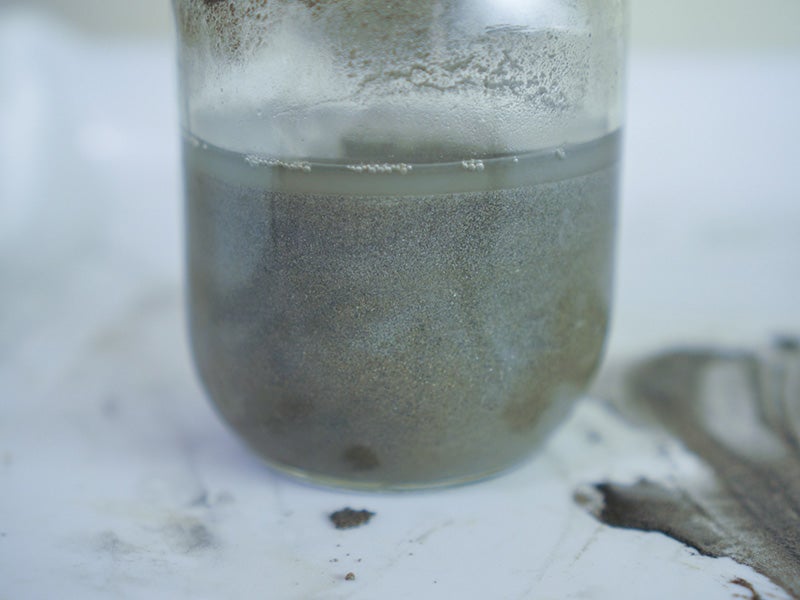A Coal Ash Clean Up Job Not Well Done
Duke Energy cleans up only six percent of coal ash into NC river, leaves the rest

This page was published 11 years ago. Find the latest on Earthjustice’s work.
When I was a boy, if I told my mother I cleaned only six percent of my room and then headed out the door to play, I’d get a swift turn back to finish the job, most likely accompanied by some harsh words and her fearsome “stink eye.” It’s a lesson we all learn at an early age: clean up all of your mess.
But apparently Duke Energy—which was responsible for the 39,000 tons of toxic coal ash and 27 million gallons of coal ash-contaminated wastewater dumped into the Dan River in North Carolina in February—feels that cleaning up only six percent of the spilled ash is good enough for them to call it quits and go home. They seem to be following the pattern of a previous claim of “Mission Accomplished” well before it actually was.
Newsweek and many other outlets reported recently that Duke Energy claimed that cleanup of the spill was complete. Duke itself claimed in a press release that “Since the operation began on May 6, approximately 2,500 tons of coal ash and river sediment have been removed” from the Dan River near the Dan River Steam Station where the spill occurred. Once they got that coal ash cleaned up, they called it a day and ended the cleanup process, leaving approximately 36,000 tons behind.
But environmental groups (and pretty much any reasonable person who has ever had to clean up a mess) are not convinced that the six percent solution results in anything approaching “clean.” “Where are the other 37,000 tons?” said Kathleen Sullivan, with the Southern Environmental Law Center. “They have not accounted for 94 percent of the coal-ash waste spilled into the Dan River. Duke has removed about 6 percent of the coal-ash waste it spilled and at just two places: at the spill site itself and the Danville dam. It is hard to believe that the coal ash hasn’t collected elsewhere in places in the river where it could be removed.”
Waterkeeper Alliance attorney Pete Harrison said, “This arrogant announcement from Duke Energy is the ultimate insult to the people of North Carolina and Virginia whose river has been devastated by the company’s toxic ash spill.” Pete conducted testing on the Dan River last week, after the announcement from Duke Energy and found a thick black plume of coal ash just inches below the bottom of the river.
But they’re not alone. Tim White, a columnist with the Fayetteville Observer in North Carolina opined that the people living along the Dan River shouldn’t be satisfied with such a meager cleanup. White wrote, “And the rest of us who live downstream from other Duke ash ponds might pay heed to this. The lousy return on investment is a good reason why we shouldn’t trust Duke and its regulators to keep us safe. And good reason why the company should be compelled to move all of the ash from all of the ponds to safe storage away from the water supplies of major population centers—and not at just four out of 14 sites.”
The coal ash problem in North Carolina continues as more sites are found to be contaminating nearby waters with coal ash. It doesn’t take a catastrophic spill of thousands of tons of ash to cause a problem; the slow, steady leak of this toxic waste into the waters where we swim, fish and drink is a silent killer. And unfortunately, the problem is not limited to North Carolina. The EPA is set to finalize long-awaited federal coal ash regulations that will protect communities from disasters like this one. Let’s just hope the rules are in place before another disaster occurs.
Past Coverage of the Dan River Coal Ash Disaster
- North Carolina Regulators Ding Duke for a Penny Per Toxic Ton (Feb. 24, 2014): Duke Energy’s $99,000 penalty was nothing—it’s like someone who earns $50,000 a year, getting a fine of $1.90. Barely amounting to a library fine, this is no deterrent for the likes of Duke.
- East of Eden: North Carolina Toxic Coal Ash Spill Defies State Borders (Feb. 10, 2014): Hellish coal ash mess in North Carolina is Virginia’s problem, too.
- North Carolina Coal Ash Spill Demonstrates Urgent Need to Close Ponds (Feb. 6, 2014): Duke Energy dumps 8,000 pounds of arsenic into the Dan River.
Earthjustice’s Washington, D.C., office works at the federal level to prevent air and water pollution, combat climate change, and protect natural areas. We also work with communities in the Mid-Atlantic region and elsewhere to address severe local environmental health problems, including exposures to dangerous air contaminants in toxic hot spots, sewage backups and overflows, chemical disasters, and contamination of drinking water. The D.C. office has been in operation since 1978.